Abstract
OBJECTIVE: To prevent the recurrence of neural tube defects (NTDs) in families at increased risk of having offspring with NTDs with the use of periconceptional folic acid supplementation. OPTIONS: Genetic counselling and prenatal diagnosis of NTDs. OUTCOMES: NTDs cause stillbirth, neonatal death and severe disabilities. The cost for medical care and rehabilitation in the first 10 years of life of a child with spina bifida cystica was estimated to be $42,507 in 1987. EVIDENCE: The authors reviewed the medical literature, communicated with investigators from key studies, reviewed policy recommendations from other organizations and drew on their own expertise. A recent multicentre randomized controlled trial showed that among women at high risk of having a child with an NTD those who received 4 mg/d of folic acid had 72% fewer cases of NTD-affected offspring than nonsupplemented women. Two previous intervention studies also demonstrated that folic acid supplementation was effective in reducing the rate of NTD recurrence. Several retrospective studies support this conclusion. VALUES: Recommendations are the consensus of the Clinical Teratology Committee of the Canadian College of Medical Geneticists (CCMG) and have been approved by the CCMG Board. The committee believes that primary prevention of NTDs is preferable to treatment or to prenatal detection and abortion. BENEFITS, HARMS AND COSTS: Folic acid supplementation should result in fewer NTDs among infants in Canada and ancillary savings in medical costs. The recommended dosage of folic acid is not known to be associated with adverse effects. Higher dosages of folic acid may make vitamin B12 deficiency difficult to diagnose and may alter seizure frequency in patients with epilepsy due to drug interactions with anticonvulsants. RECOMMENDATIONS: A minimum dosage of folic acid of 0.8 mg/d, not to exceed 5.0 mg/d, is recommended along with a well-balanced, nutritious diet for all women who are at increased risk of having offspring with NTDs and who are planning a pregnancy or may become pregnant. Supplementation should begin before conception and continue for at least 10 to 12 weeks of pregnancy. VALIDATION: These guidelines are similar to those of the Society of Obstetricians and Gynaecologists of Canada, the US Centers for Disease Control and Prevention and the Department of Health in Britain. SPONSORS: These guidelines were developed by the CCMG Clinical Teratology Committee and endorsed by the Board of the CCMG. No funding for the development of these guidelines was obtained from any other sources.
Full text
PDF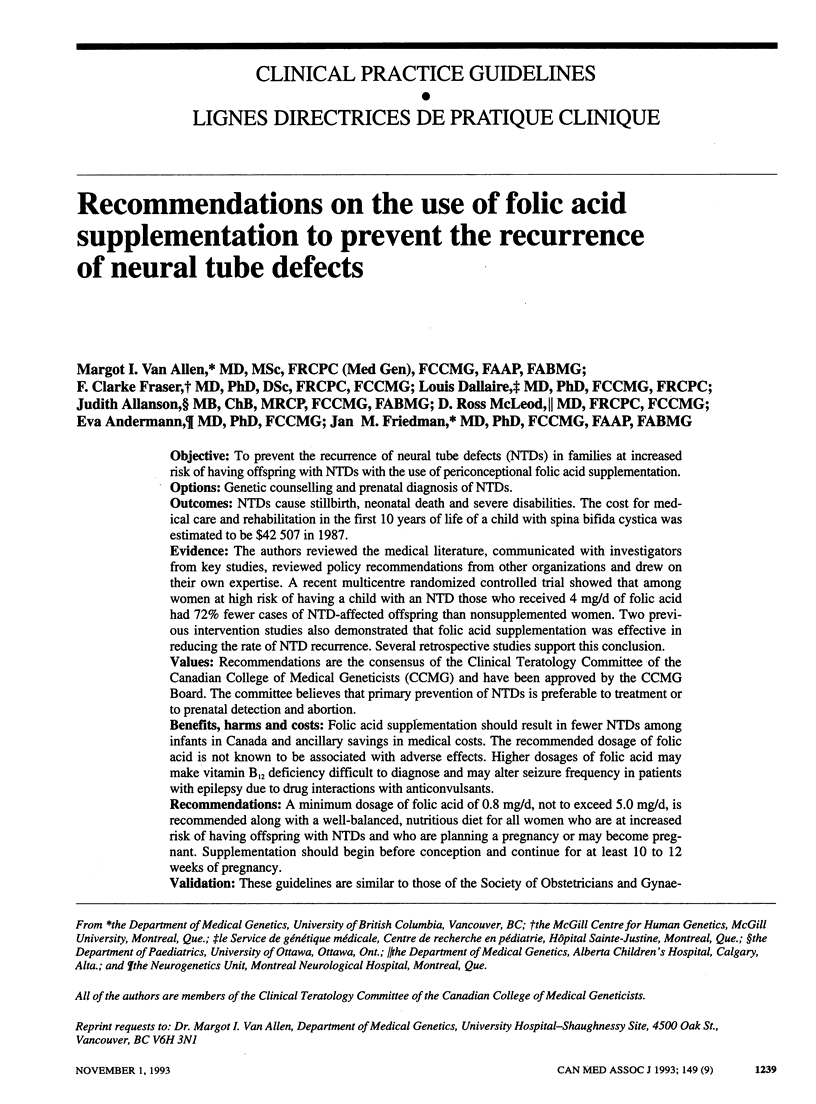
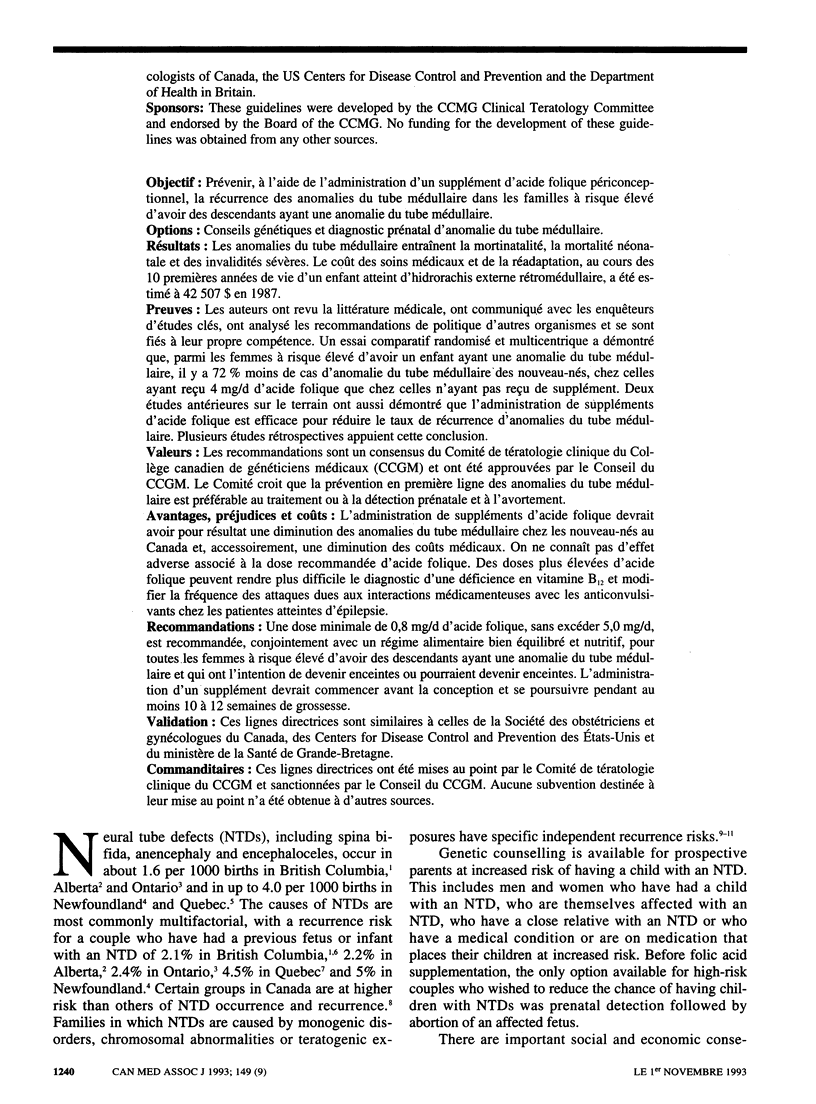
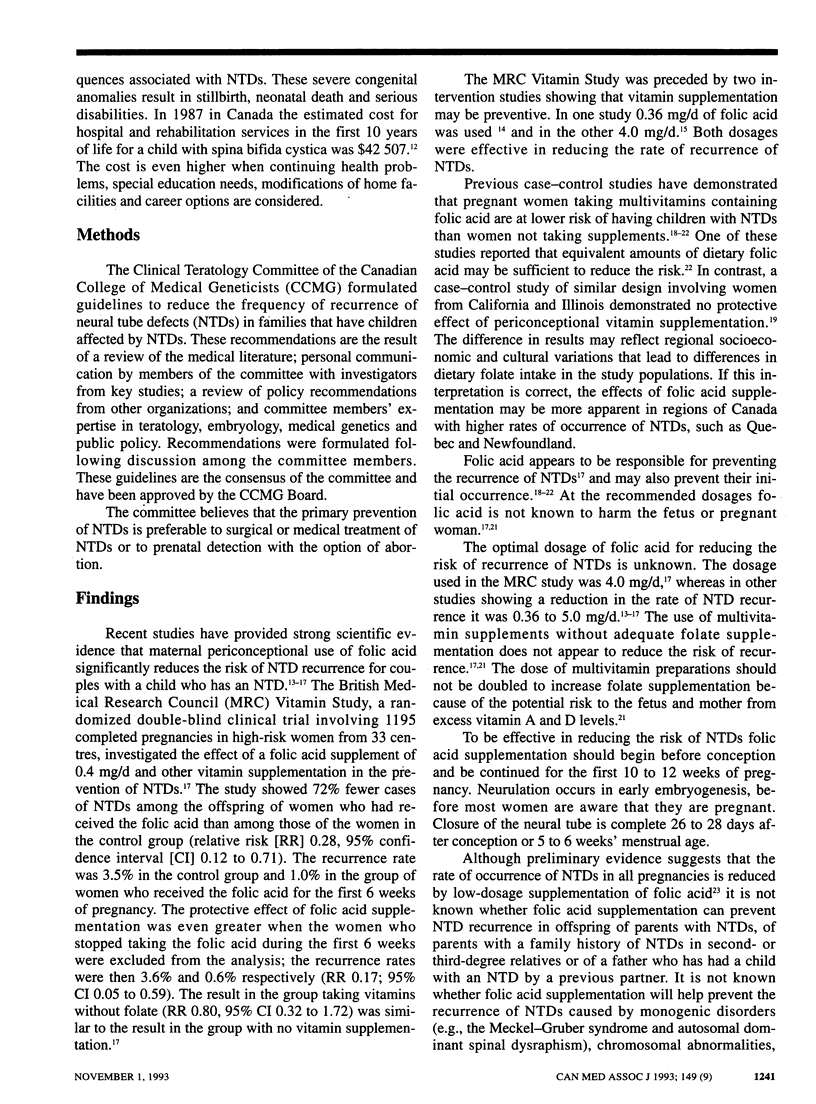
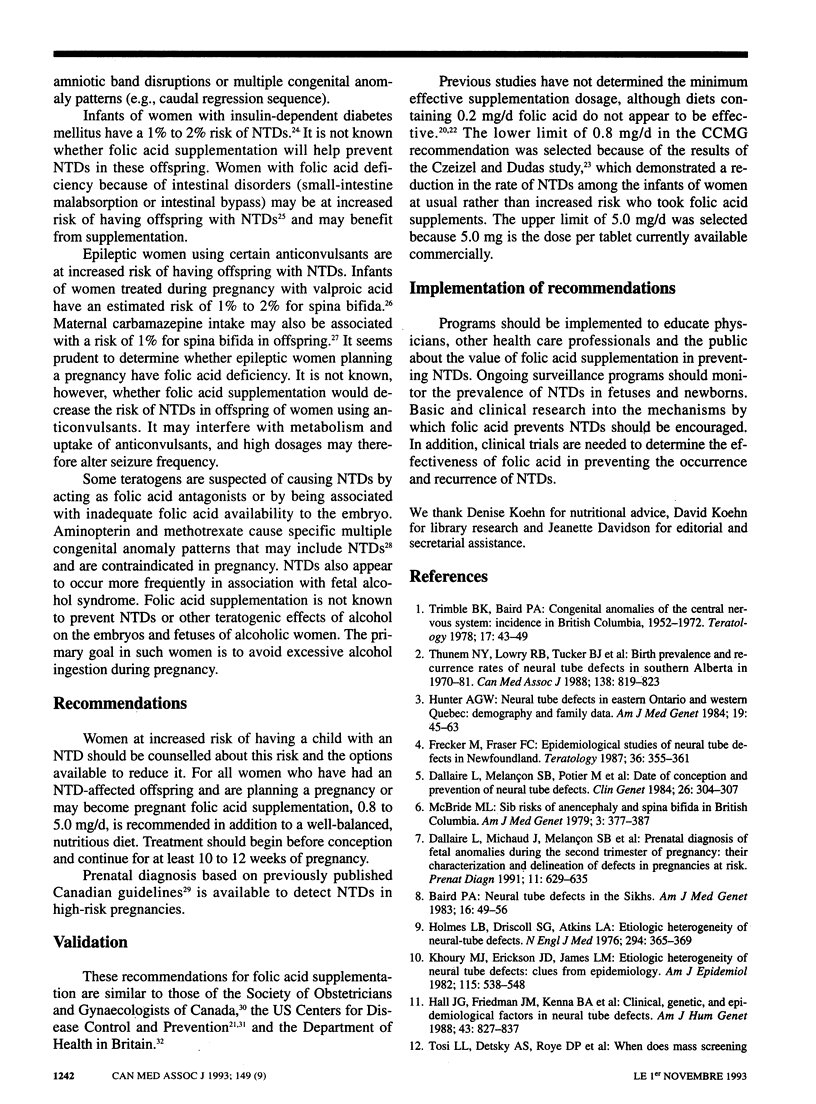
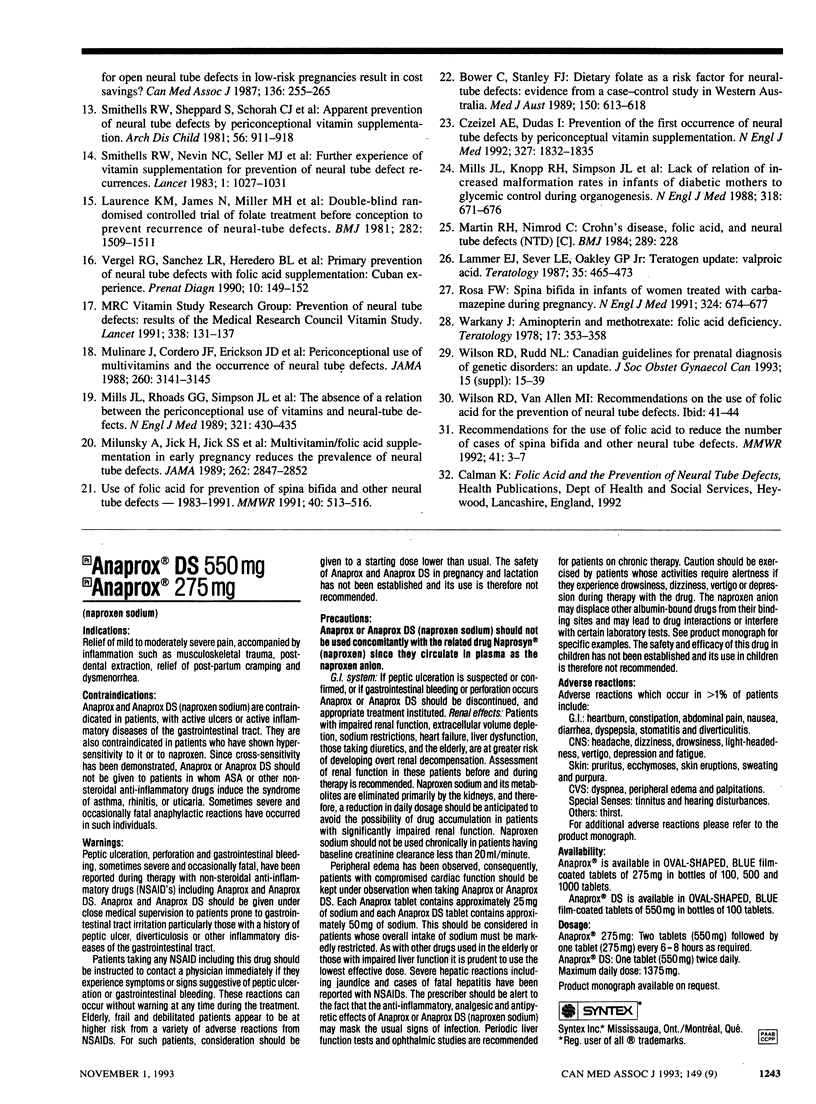
Selected References
These references are in PubMed. This may not be the complete list of references from this article.
- Baird P. A. Neural tube defects in the Sikhs. Am J Med Genet. 1983 Sep;16(1):49–56. doi: 10.1002/ajmg.1320160109. [DOI] [PubMed] [Google Scholar]
- Bower C., Stanley F. J. Dietary folate as a risk factor for neural-tube defects: evidence from a case-control study in Western Australia. Med J Aust. 1989 Jun 5;150(11):613–619. doi: 10.5694/j.1326-5377.1989.tb136723.x. [DOI] [PubMed] [Google Scholar]
- Czeizel A. E., Dudás I. Prevention of the first occurrence of neural-tube defects by periconceptional vitamin supplementation. N Engl J Med. 1992 Dec 24;327(26):1832–1835. doi: 10.1056/NEJM199212243272602. [DOI] [PubMed] [Google Scholar]
- Dallaire L., Melançon S. B., Potier M., Mathieu J. P., Ducharme G. Date of conception and prevention of neural tube defects. Clin Genet. 1984 Oct;26(4):304–307. doi: 10.1111/j.1399-0004.1984.tb01064.x. [DOI] [PubMed] [Google Scholar]
- Dallaire L., Michaud J., Melancon S. B., Potier M., Lambert M., Mitchell G., Boisvert J. Prenatal diagnosis of fetal anomalies during the second trimester of pregnancy: their characterization and delineation of defects in pregnancies at risk. Prenat Diagn. 1991 Aug;11(8):629–635. doi: 10.1002/pd.1970110821. [DOI] [PubMed] [Google Scholar]
- Frecker M., Fraser F. C. Epidemiological studies of neural tube defects in Newfoundland. Teratology. 1987 Dec;36(3):355–361. doi: 10.1002/tera.1420360312. [DOI] [PubMed] [Google Scholar]
- Hall J. G., Friedman J. M., Kenna B. A., Popkin J., Jawanda M., Arnold W. Clinical, genetic, and epidemiological factors in neural tube defects. Am J Hum Genet. 1988 Dec;43(6):827–837. [PMC free article] [PubMed] [Google Scholar]
- Holmes L. B., Driscoll S. G., Atkins L. Etiologic heterogeneity of neural-tube defects. N Engl J Med. 1976 Feb 12;294(7):365–369. doi: 10.1056/NEJM197602122940704. [DOI] [PubMed] [Google Scholar]
- Hunter A. G. Neural tube defects in Eastern Ontario and Western Quebec: demography and family data. Am J Med Genet. 1984 Sep;19(1):45–63. doi: 10.1002/ajmg.1320190108. [DOI] [PubMed] [Google Scholar]
- Khoury M. J., Erickson J. D., James L. M. Etiologic heterogeneity of neural tube defects: clues from epidemiology. Am J Epidemiol. 1982 Apr;115(4):538–548. doi: 10.1093/oxfordjournals.aje.a113335. [DOI] [PubMed] [Google Scholar]
- Lammer E. J., Sever L. E., Oakley G. P., Jr Teratogen update: valproic acid. Teratology. 1987 Jun;35(3):465–473. doi: 10.1002/tera.1420350319. [DOI] [PubMed] [Google Scholar]
- Laurence K. M., James N., Miller M. H., Tennant G. B., Campbell H. Double-blind randomised controlled trial of folate treatment before conception to prevent recurrence of neural-tube defects. Br Med J (Clin Res Ed) 1981 May 9;282(6275):1509–1511. doi: 10.1136/bmj.282.6275.1509. [DOI] [PMC free article] [PubMed] [Google Scholar]
- McBride M. L. Sib risk of anencephaly and spina bifida in British Columbia. Am J Med Genet. 1979;3(4):377–387. doi: 10.1002/ajmg.1320030409. [DOI] [PubMed] [Google Scholar]
- Mills J. L., Knopp R. H., Simpson J. L., Jovanovic-Peterson L., Metzger B. E., Holmes L. B., Aarons J. H., Brown Z., Reed G. F., Bieber F. R. Lack of relation of increased malformation rates in infants of diabetic mothers to glycemic control during organogenesis. N Engl J Med. 1988 Mar 17;318(11):671–676. doi: 10.1056/NEJM198803173181104. [DOI] [PubMed] [Google Scholar]
- Mills J. L., Rhoads G. G., Simpson J. L., Cunningham G. C., Conley M. R., Lassman M. R., Walden M. E., Depp O. R., Hoffman H. J. The absence of a relation between the periconceptional use of vitamins and neural-tube defects. National Institute of Child Health and Human Development Neural Tube Defects Study Group. N Engl J Med. 1989 Aug 17;321(7):430–435. doi: 10.1056/NEJM198908173210704. [DOI] [PubMed] [Google Scholar]
- Milunsky A., Jick H., Jick S. S., Bruell C. L., MacLaughlin D. S., Rothman K. J., Willett W. Multivitamin/folic acid supplementation in early pregnancy reduces the prevalence of neural tube defects. JAMA. 1989 Nov 24;262(20):2847–2852. doi: 10.1001/jama.262.20.2847. [DOI] [PubMed] [Google Scholar]
- Mulinare J., Cordero J. F., Erickson J. D., Berry R. J. Periconceptional use of multivitamins and the occurrence of neural tube defects. JAMA. 1988 Dec 2;260(21):3141–3145. [PubMed] [Google Scholar]
- Rosa F. W. Spina bifida in infants of women treated with carbamazepine during pregnancy. N Engl J Med. 1991 Mar 7;324(10):674–677. doi: 10.1056/NEJM199103073241006. [DOI] [PubMed] [Google Scholar]
- Smithells R. W., Nevin N. C., Seller M. J., Sheppard S., Harris R., Read A. P., Fielding D. W., Walker S., Schorah C. J., Wild J. Further experience of vitamin supplementation for prevention of neural tube defect recurrences. Lancet. 1983 May 7;1(8332):1027–1031. doi: 10.1016/s0140-6736(83)92654-5. [DOI] [PubMed] [Google Scholar]
- Smithells R. W., Sheppard S., Schorah C. J., Seller M. J., Nevin N. C., Harris R., Read A. P., Fielding D. W. Apparent prevention of neural tube defects by periconceptional vitamin supplementation. Arch Dis Child. 1981 Dec;56(12):911–918. doi: 10.1136/adc.56.12.911. [DOI] [PMC free article] [PubMed] [Google Scholar]
- Thunem N. Y., Lowry R. B., Tucker B. J., Medd B. W. Birth prevalence and recurrence rates of neural tube defects in southern Alberta in 1970-81. CMAJ. 1988 May 1;138(9):819–823. [PMC free article] [PubMed] [Google Scholar]
- Tosi L. L., Detsky A. S., Roye D. P., Morden M. L. When does mass screening for open neural tube defects in low-risk pregnancies result in cost savings? CMAJ. 1987 Feb 1;136(3):255–265. [PMC free article] [PubMed] [Google Scholar]
- Trimble B. K., Baird P. A. Congenital anomalies of the central nervous system incidence in British Columbia, 1952-72. Teratology. 1978 Feb;17(1):43–49. doi: 10.1002/tera.1420170111. [DOI] [PubMed] [Google Scholar]
- Unreviewed reports. Br Med J (Clin Res Ed) 1984 Jul 28;289(6439):228–228. [PMC free article] [PubMed] [Google Scholar]
- Vergel R. G., Sanchez L. R., Heredero B. L., Rodriguez P. L., Martinez A. J. Primary prevention of neural tube defects with folic acid supplementation: Cuban experience. Prenat Diagn. 1990 Mar;10(3):149–152. doi: 10.1002/pd.1970100303. [DOI] [PubMed] [Google Scholar]
- Warkany J. Aminopterin and methotrexate: folic acid deficiency. Teratology. 1978 Jun;17(3):353–357. doi: 10.1002/tera.1420170314. [DOI] [PubMed] [Google Scholar]


